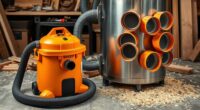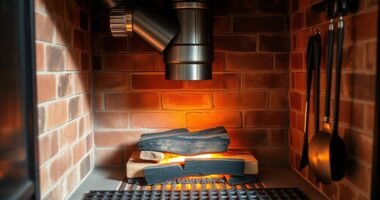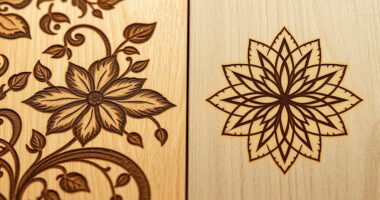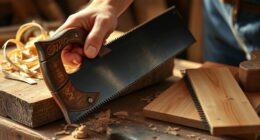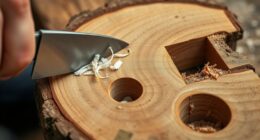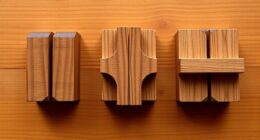To keep your wood burner running safely and efficiently, clean it regularly by removing ash from the firebox and checking for creosote buildup in the chimney. Replace worn or damaged components like the fire grate and tips promptly to prevent airflow issues. Schedule annual inspections with professionals to catch potential hazards early. For more tips on maintaining your wood burner and extending its lifespan, continue exploring best practices for cleaning and part replacement.
Key Takeaways
- Regularly clean the firebox and remove creosote buildup to prevent chimney fires and improve efficiency.
- Empty ash pans weekly during heavy use, using a metal container with a tight lid for safe disposal.
- Inspect and replace worn internal components like the fire grate to maintain proper airflow and heat output.
- Schedule annual chimney inspections with a professional to identify blockages, creosote buildup, or structural issues.
- Follow manufacturer instructions for cleaning and maintenance, and conduct safety checks before and after each heating season.
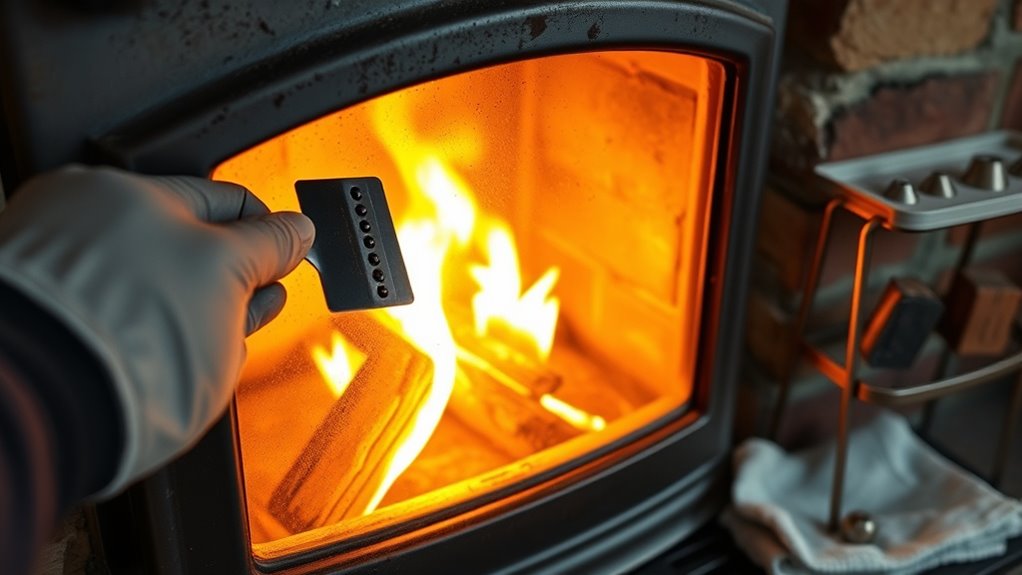
Regular maintenance is essential to keep your wood burner operating efficiently and safely. One of the most critical aspects of maintenance is ensuring your chimney is in good condition. A thorough chimney inspection should be part of your routine, especially before the heating season begins. This inspection helps identify creosote buildup, blockages, or any structural issues that could pose a fire hazard or reduce airflow. If you notice excessive soot or a strong odor coming from your chimney, it’s time to schedule an inspection. Keeping your chimney clean not only prevents dangerous buildup but also improves the overall efficiency of your wood burner, allowing it to burn cleaner and produce more heat with less fuel.
Regular chimney inspections ensure safety and maximum efficiency for your wood burner.
Ash management is another vital component of maintaining your wood burner. Over time, ashes accumulate and can obstruct airflow if not regularly removed. You should check and empty the ash pan frequently—preferably once a week during heavy use—to prevent ash from spilling into the firebox and smothering your fire. When removing ashes, use a metal container with a tight-fitting lid to prevent any stray embers from igniting nearby materials. Proper ash disposal is crucial for safety and for keeping your wood burner working optimally. Remember, never leave hot ashes unattended, and always ensure they are completely extinguished before disposal.
In addition to managing ashes and inspecting the chimney, you should also pay attention to the condition of your fire grate and other internal components. Over time, these can become warped or damaged, affecting airflow and combustion. Replacing worn-out parts promptly maintains efficient burning and helps prevent unnecessary wear on your entire system. Regularly cleaning the firebox and removing soot buildup on internal surfaces also enhances heat output and extends the lifespan of your wood burner.
Routine cleaning and inspection are simple steps that save you money and improve safety. By keeping your chimney free of creosote and ensuring proper ash management, you reduce the risk of chimney fires and improve your heater’s performance. Don’t neglect these tasks—set a schedule, stay consistent, and your wood burner will serve you well for many years. Remember, safety first: always follow manufacturer instructions and consider consulting a professional for an annual chimney inspection. Conducting regular safety inspections helps identify potential hazards early and ensures compliance with local fire safety regulations, safeguarding your home and loved ones. Doing so ensures that your wood-burning system remains efficient, safe, and ready to keep your home warm during the cold months.
Frequently Asked Questions
How Often Should I Replace the Glass in My Wood Burner?
You should replace the glass in your wood burner when it becomes cracked, chipped, or shows signs of excessive wear. Regularly inspecting the glass as part of your inspection schedule helps catch damage early. Typically, you’ll need to replace the glass every couple of years, but this depends on usage and the quality of the glass. Always follow manufacturer guidelines and consult a professional if you’re unsure about the condition of your glass.
Can I Use Regular Cleaning Products on My Wood Burner?
Using regular cleaning products on your wood burner is like bringing a sledgehammer to a delicate repair. Stick to cleaning safety guidelines and choose products specifically designed for fireplaces. These guarantee you don’t damage the glass or metal components. Product selection is key; avoid harsh chemicals that could corrode or stain. Always follow manufacturer instructions to keep your wood burner shining safely and efficiently, like a well-tuned orchestra.
What Are Signs That My Door Gasket Needs Replacing?
You’ll know your door gasket needs replacing if you notice drafts, reduced heat efficiency, or difficulty sealing the door. To check, perform a door gasket inspection by closing the door on a piece of paper; if it slips out easily, it’s time for gasket replacement tips. Regularly inspect and replace the gasket to maintain a tight seal, ensuring your wood burner operates safely and efficiently.
How Do I Prevent Creosote Buildup Effectively?
Think of creosote buildup like a slow leak in a pipe—if ignored, it causes bigger problems. To prevent it, schedule regular chimney inspections and remove ash regularly, as ash can trap moisture and promote creosote formation. Keeping your wood burner burning efficiently minimizes smoke and creosote. Use dry, seasoned wood and avoid overfiring. Consistent maintenance guarantees safe, clean operation and reduces fire risk.
Is It Necessary to Schedule Professional Maintenance Regularly?
Yes, scheduling professional maintenance regularly is important. You should arrange for a professional inspection annually to guarantee your wood burner operates safely and efficiently. During this inspection, a certified technician can assess for any issues, perform necessary safety certification, and recommend repairs or cleaning. Regular professional maintenance helps prevent hazards like creosote buildup and keeps your burner running smoothly, ensuring safety and ideal performance throughout the season.
Conclusion
Just as a gardener tends to each plant with care, so too must you nurture your wood burner. Regular cleaning and timely tip replacement keep it burning bright, ensuring warmth and safety through each season. Think of it as tending a steady flame—once tended, it will serve you well, glowing softly like a guiding star. With simple upkeep, your wood burner remains a trusted friend in your home’s heart, always ready to ignite comfort and coziness anew.

